Official Name
Ljubljana. The name probably derives from the Slavic word "ljubit'", which means 'to love' but, 'ljubljana' means The Beloved. What a nice name for a town. In ancient Rome, the town was known as Iulia Aemona, sometimes abbrivated Emona. Ljubljana has a long German history - Germans referred and refer to the town as Laibach.
Location

| ||
| Ljubljana |
Ljubljana straddles the small river Ljubljanica in the centre of Western Slovenia. The Adriatic Sea coast is around 150 km away (as the crow flies). The Julian Alps to the north are not very far. There are some mountains with an altitude of 1,000 m or more in the vicinity. Wide parts of Ljubljana were built on marshland.
Population
Some 257,000 inhabitants (2002). And so Ljubljana is by far the biggest town in Slovenia. However, the netto growth rate is negative (I guess this will change within the next years).
Orientation
The setting of Ljubljana is very lovely: There's a small river, some hills and more. The town itself is quite compact. The main train station lies north of the centre of town and is quite small. The bus terminal is conveniently located on the street in front of the train station. The area around the station is relatively new and modern.
Walk out the train station, turn right and after two or three minutes you will get to a wide and busry road. This is the main road called Slovenska cesta, leading dead straight to the south. Along the road, countless banks and office buildings as well as boutiques, restaurants etc line up - it's Ljubljana's first place. You can't miss the centre of the old town. Just walk along Slovenska Cesta southwards for one kilometre or so. There you will a notice a narrow pedestrian zone to your left. This road is called Nazorjeva ul. (ul.=street). Follow the road and soon you will find yourself standing in the middle of Prešernov trg (trg=square) - a nice square bustling with life, dominated by a monument in the middle and a beautiful church facing the square. There you will also notice some small bridges spanning the river Ljubljanica.
Along the road to the right, following the river southwards, numerous nice restaurants line up. And so the area is crowded not just during the daytime. On the other side of the river you can see a large hill with the remainings of a castle on the top. At the foot of the hill, there's the historic core of Ljubljana with narrow lanes, more or less small houses and a large cathedral. Apart from the district around the train station, Ljubljana is a very green and pleasant town with many parks. It's fun to simply walk around, and since the town is not very big, it's virtually impossible to get lost. As small as a provincial town, as busy and multifarious as a capital - that's Ljubljana.
History
Legend says that Ljubljana was founded by Iason and the Argonauts. According to ancient Greek mythology, Iason went to Colchis (in present-day →Georgia) to get the Golden Fleece. After he and his men succeeded, they sailed back via the Black Sea, following the river Danube and finally went into some tributaries. At present-day Ljubljana, they were challenged by a fiery dragon. And so the dragon became the symbol of town.
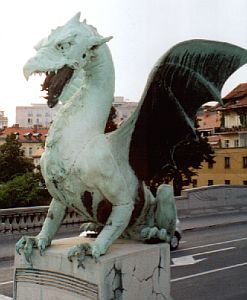
| ||
| Symbol of Ljubljana: The Dragon |
Back to the hard facts: Geographically spoken, the town occupies a very favourable place. And so it was inhabited long before the dawn of recorded history. Romans founde a first small settlement around the year 50 BC and named it Emona, but the Roman time lies a little bit outside of present-day Ljubljana. The town developed for around 500 years, before it was levelled by the invading Huns. After their arrival in the region, the Slav tribe of the Slovenes erected a fortress on the top of the hill. Soon, a small town followed at the foot of the hill. After the 11th century, Ljubljana developed into a local centre and market town. In the year 1144, the German name "Laibach" was mentioned for the first time. The Slavic version appeared much later. During the 13th century, the town experienced its first real heyday when it became the capital of the province. In 1335, the town as well as the area around were taken over by the Habsburgs, but nothing changed - Ljubljana kept on flourishing, gradually developing into an important trade centre. It was a multicultural society - many Germans, Italians, Jews, Spanyards and others lived in town.
In 1461, the bishop chose Ljubljana as his residence. A massive earthquake destroyed large parts of the town in 1511, but almost all was rebuilt - in the Renaissance style. The protestant movement had a strong influence in Ljubljana, but the Habsburg rulers enforced re-Catholization of the citizens. The town developed culturally, too - a philharmonic theatre was built, and many artists moved to Ljubljana. After invading the entire region, Napoleon established the Illyrian Province from 1809 to 1813 and made Ljubljana the capital of the province. This again initiated a new boom. In 1849, Ljubljana became a Habsburg ruled town again. In the same year, the town was connected to the railroad network. Another destructive earthquake hit the town in 1895. After that, Ljubljana was given a massive facelift.
Ljubljana was widely spared by the First World War. In 1918, the town became the capital of Slovenia, which again was part of the newly founded Kingdom of Serbs, Croats and Slovenians, to be renamed Yugoslavia a few years later. During the decades between the two World Wars, the magnificent architect Jože Plečnik changed the appearance of the town centre. Much of the town's charm as it can be experienced today was created during that period. In World War II, Ljubljana was seized by Italian and German forces. There was a strong resistance among the citizens, and so the entire town was sealed by surrounding it with a barbed wire fence.
Fortunately, Ljubljana was neither heavily damaged during World War II nor during the 10-days War in 1991. After declaring independence from Yugoslavia in 1991, Ljubljana became the capital of Slovenia again - and the capital is booming.
Getting there / transportation
Naturally, Ljubljana is the main transport hub of Slovenia. Many international trains stop in Ljubljana, and all destinations within the country can be reached easily. For detailed information on international train connections see →Travel Information Slovenia. In Ljubljana, buses are the best way to get around. The International Airport Brnik lies around 20 km north of the town centre. Shuttle buses as well as normal buses, the latter leave from the square in front of the train station, run between the airport and the town.
To get it straight: The best thing about Ljubljana is its size. Although it's the capital of the country, it's simply a nice, small and very pleasant, but still vibrant town. The small centre of town is clearly dominated by a large hill. Some steep paths lead to the top of the hill. There you will find the impressive Ljubljanski Grad (=fortress). As already mentioned above, the fortress was built in the year 1144 and belongs to the oldest part of the town. At present, the fortress is under reconstruction (as of 2001), but it looked like it will take a couple of years. It's quite spacious inside, and there's much to see inside. Climbing the old watchtower is definitely recommended - the tower provides a splendid view over the town. The tower itself is interesting, too - there are two separate spiral staircases running parallel to each other (of course), which looks very unusual when you look from the bottom to the top or vice versa (see also →Travelogue).
Another goodie is the virtual city museum inside the tower, offering an informative show about the history of town. Other sights inside the castle include a pentagonal tower, an exhibition and interesting excavation sites. There's also a nice café called Grajski Salon, where you can sit outside sipping an espresso while watching the scenery. All in all, the castle is good for a nice walk. Entrance fee is around € 1.
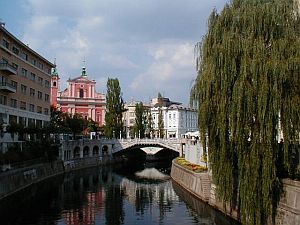
| ||
| Triple Bridge and Franciscan Church |
The area along the small river Ljubljanica is particularly beautiful. There, some weeping willows, several more or less old buildings and picturesque colonnades line up along the river side. The latter were planned by Ljubljana's most important architect Plečnik. The absolute centre of town is defined by the Tromostovje (Triple Bridge). The bridge in the middle was already built during the 19th century, is a little bit wider and open to traffic. The other two bridges were added in the year 1931 by - you name it - Plečnik. It's an unconventional though very nice sight. North of the Triple Bridge stretches the small Prešernov trg. Prešeren was a famous poet, to whom not only the square but also a monument in the middle of it was dedicated. The square seems to be a very popular meeting point - even at night it's bustling with life.
The light red Frančiškanska Cerkev (Franciscan Church) built in the year 1660 is another eyecatcher. There are also some nice Art Noveau buildings facing the square. Additionally, there are two narrow pedestrian zones with countless shops and cafés starting from the square. The perfect place for a nice stroll (and maybe some shopping) so to say. Especially in warm summer evenings, many street performers entertain the people between the square and the Triple Bridge. When you walk south from the square along Hribarjevo nabrežje (Hribarjev riverside promenade), you won't have any difficulties finding a nice restaurant, usually featuring a terrace.
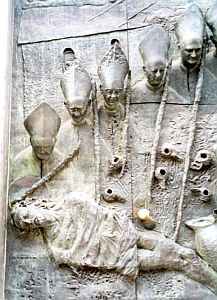
| ||
| The splendid door of the Cathedral |
The small district at the foot of castle hill on the other side of the river has plenty to offer as well. This is the real old town, which is much older than the area around Prešeren Square. The district is dominated by several very old houses and a network of narrow lanes. There you will also find the Rotovž (City Hall) facing one of the two beautiful squares in the district. Probably the tallest building in that area, Ljubljanski Stolnica (Ljubljana Cathedral), also known as St Nicholas Church, will attract your attention. The twin-towered church was built in the year 1708. The large doors of the south side are probably much newer but highly interesting - I've only seen something similar in →Olomouc (Czech Republic).
Only a few hundred metres away, the so-called Zmajski most (Dragon Bridge) spans the river. The bridge head is guarded by lovely dragon statues (see picture at the top), reminding the visitor of the legend regarding the foundation of town. There's also the modern, socialist-Yugoslav Ljubljana, mainly concentrating around Trg republike (Republic Square). Thanks heavens that the urban developers refrained from building the concrete desert right in the middle of town! If this would be →Romania, I'm sure they would have done so. Republic Square is several hundred metres away from the Triple Bridge in the western part of the centre. When you walk north from there, you will find the cultural heart of Ljubljana: The National Museum, the Modern Art Gallery, the Opera, the National Gallery etc concentrate in a very small area. Further to the west, there's the so-called Tivolski Park (Tivoli) - the lungs of the capital.
The list of sights is not complete - there's much more to see in Ljubljana. Although the town is small, it's definitely worth a few days stay. For us, Ljubljana was a very pleasant surprise.
Postojna
In Slovenia, namely in the area between Ljubljana and the Adriatic Sea coast, there's a wide karst territory (see also →Geography of Slovenia) with all the appropriate karst phenomena - among them the countless stalactite caves. One of the most famous caves can be found near Postojna (German name: Adelsberg) some 65 km south-west of the capital. Postojna is also one of the exits along the motorway connecting the capital with the coast. The caves themselves are called Postojnska jama. The Postojna cave system is considered to be the world's third-largest underground network (as far as speleologists can say by now). The caves were first examined in 1818. The entire network is around 27 km long. It is estimated that parts of the system are around 100,000 years old.
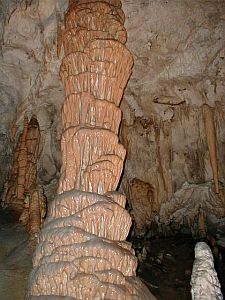
| ||
| Stalagnate* in Postojna |
In karst areas, small rivers dissolve massive limestone layers creating more or less large caves. In Postojna, a tiny underground train carries the visitors through the caves. Somewhere the train stops, so that you can walk the last stretch all the way to the exit. The entire tour takes around 1½ hours. Among other things, you can see a concert hall, a salamander-like white, eyeless creature as it can be found in many other caves worldwide, and all the typical cave formations, eg stalagmites, stalagtites etc. Every year, around 800,000 visitors make their way to Postojna. However, since the caves are open to the public for a very long time, there's a lot of damage. And you can only walk through the caves in large groups. If you've never been inside a cave network, you might find this place interesting. If you've already been to other, even smaller caves, you will be disappointed. The tour will set you back € 8. Opening hours correspond to the time of the year - in summer, there's one tour starting every full hour. Near the entrance you will find countless souvenir shops, restaurants and food stalls. Several daily buses run from Ljubljana to Postojna - the fare is € 9. As far as I've heard, the Škocjan Caves are much better, but it's hard to get their without your own transport.
* It's no mistake! Stalagmites point upwards from the floor of the cave, stalagtites hang down from the ceiling. When both of them merge, they form a massive column called stalagnate.
Trieste (Trst) - Italy
Apparently, Italy has much more money than Slovenia, and so they could buy more vowels: The Italian town Trieste is known as Trst to Slovenians. Trieste is no Slovenian town, but it has and always had strong ties with Slovenia's history. Trieste was founded during the 2nd century BC by the Romans and soon it grew quickly. The name simply means market town. In 1236, Trieste cut its ties with Venetia (Venice) in order to become a free town. Later on, Trieste decided to join the empire of the Habsburg Monarchy. That was excellent news for the Habsburgs - ever since, Austria had a large Mediterranean Sea port. Therefore Trieste was in a very privileged position and developed very well. It also became a remarkably cosmopolitan and multireligious community.
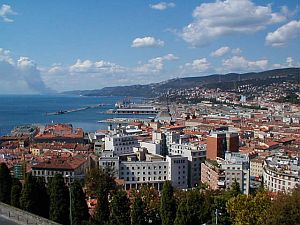
| ||
| A view over Triest from the citadel |
Although Trieste hadn't had anything to do with Italy for a very long time, the town was added to Italy after the defeat of Austria-Hungary in the year 1918. Now it was only one of many Italian towns, and so Trieste lost much of its importance. In 1945, Yugoslavia claimed the town and seized it. According to the Treaty of Paris in 1947, Trieste was declared Territorio Libero di Trieste (Free Territory of Trieste) divided into two zones - zone A was the town itself and the stretch of land along the coastline. Zone A was first administered by allied forces. Zone B, the hinterland of Trieste, came under Yugoslav administration. The agreement was finally settled in the year 1975. However, it became an issue again when Slovenia declared independence in 1991, when former Italian refugees claimed compensation.
The town itself provides a fascination blend of medieval elements with a marvellous citadel, the flair of Venice as well as genuine Habsburg atmosphere. Life seems to be very hectic and the traffic is almost horrendous - at least the last point let you feel that you're in an Italian big city. The Slovenian-Italian border is highly frequented. Obviously, the area around Trieste is booming. The best way to get to Trieste from Ljubljana is by bus via Koper. The fare from Ljubljana to Koper is less then € 8 SIT, from there to the centre of Trieste it's a little bit more than € 2. The whole trip takes slightly more than 2 hours, there are several connections a day.
The cheapest place in the centre seems to be the large Park Hotel not far from the historic centre. The multi-storeyed building has more than 100 rooms. A plain but clean double costs € 26 Euro - provided that you have an ISIC students card (20% discount). There's a bar in the lobby; it's also possible to sit outside (but the bar closes very early). From the hotel, it's a five minutes walk to the centre westwards. To the train station north of the hotel it's a 10 minutes walk. The hotel is often frequented by large coach parties. Here's the address: Tabor 9, Tel.: (01)-433 1306.
- www.ljubljana.si Official website of Ljubljana in Slovene and English.
- www.ljubljana-calling.com Useful internet directory of Ljubljana in Slovene, German and English.
- www.trieste.com Very nice web portal of the city of Trieste with plenty of information. In Italian and English.
Do you have or do you know a good website about Ljubljana? Don't hesitate, let me know! After checking it, I would love to add it to the link list. You can submit a link by using the →contact form. Note that commercial websites will be treated differently.
©2024 Europe-East.com

 Albania
Albania Slovenia
Slovenia